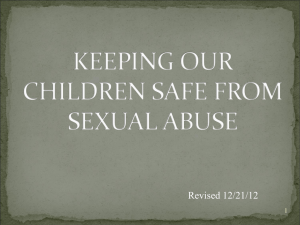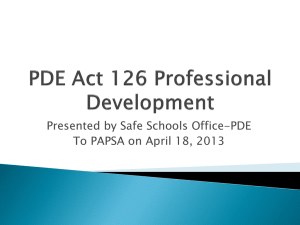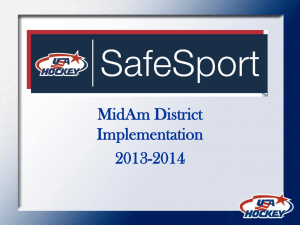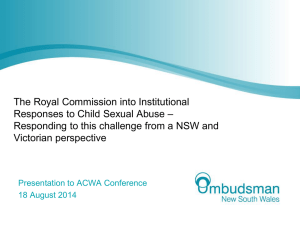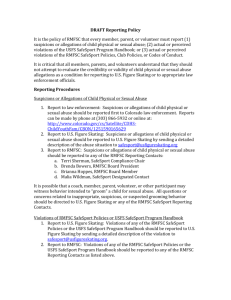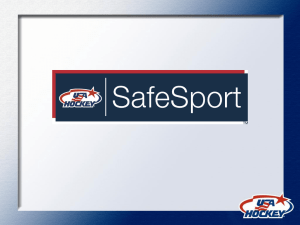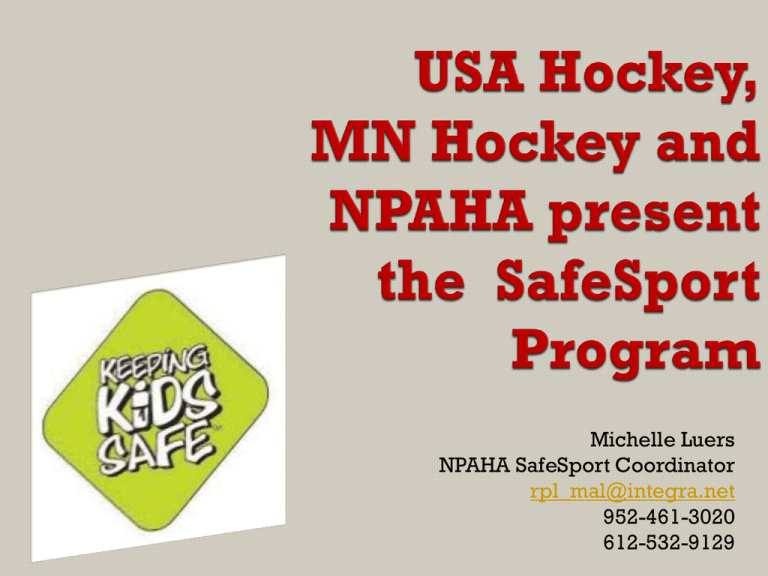
Michelle Luers
NPAHA SafeSport Coordinator
rpl_mal@integra.net
952-461-3020
612-532-9129
The USA Hockey SafeSport program was
developed to give all participants (and their
parents) confidence that they are playing our
sport in the safest possible environment, both
on and off the ice.
USA Hockey has implemented policies
addressing certain types of abuse and
misconduct, and certain policies intended to
reduce, monitor and govern the areas where
potential abuse and misconduct can occur.
Administrators within the NPAHA
Coaches
Players
Parents
Volunteers
Managers
Locker Room Monitors
Coach-Athlete Relationships
Grooming
Sexual Abuse
Physical Abuse
Emotional Abuse
Bullying, Threats and Harassment
Hazing
Signs and Symptoms of Abuse
Barriers to Reporting
Reporting and Responding to Misconduct and
Abuse
USA Hockey’s SafeSport Program has also created
guidelines regarding:
Locker Room Policy
Social Media, Mobile and Electronic
Communications Policy
Travel Policy
Billeting Policy (specifically designed for players
who stay with host families)
USA Hockey is committed to creating a safe and positive
environment for its participants’ physical, emotional, and
social development and to ensuring that it promotes an
environment free from abuse and misconduct.
USA Hockey has ZERO TOLERANCE policy
regarding any form of abuse and/or misconduct.
1 out of 8 athletes state that they have
experienced some sort of abuse or misconduct.
Abuse and misconduct is more common among
elite athletes (up to 75%).
Fully 1/3 of abuse and/or misconduct is
perpetrated by peers.
Adult abusers are typically well-liked and wellrespected.
90% of the time, children know their abuser.
Less than 10% of offenders have criminal records
that would show up on background screenings.
Coaches
create the climate.
Coaches are the single most important
factor to an individual athlete’s success.
The coach-athlete relationship is based on
two key components: trust and power.
All coach-athlete relationships have a
differential in power.
Violating the trust/power dynamic of the
relationship leads to increased control over
participants and abuse/misconduct follows.
Bullying
is the use of coercion to obtain
control over another person or to be
habitually cruel to another person
Bullying involves an intentional, persistent or
repeated pattern of committing or willfully
tolerating physical and non-physical
behaviors that are intended to cause fear,
humiliation, or physical harm
Bullying may occur in multiple forms:
verbal, physical, written or electronic
Threat is defined as, “Any written, verbal,
physical or electronically transmitted
expression of intent to physically injure or
harm someone else.”
A threat may be communicated directly to the
intended victim or communicated to a third
party.
Be particularly aware of threats made via
electronic communications.
Harrassment is “Any pattern of physical and/or
non-physical behaviors that are intended to:
cause fear, humiliation, or annoyance,
offend or degrade,
create a hostile environment, or
reflect discriminatory bias
in an attempt to establish dominance, superiority,
or power over an individual participant or group
based on gender, race, ethnicity, culture, religion,
sexual orientation, gender expression, or mental or
physical disability.”
Inappropriate
or obscene gestures
Comments related to a person’s gender,
ethnicity, race, culture, religion or sexual
orientation
Withholding or reducing playing time
due to an individual’s differences
Group segregation of an individual
based on that person’s unique
characteristics
Unwelcome
sexual advancements or sexual
comments
Verbal or nonverbal physical conduct of a
sexual nature
Explicit or implicit statements that sexual
behavior is initiated as a condition for a
participants involvement
ANY conduct of a sexual nature between an
adult and a minor is considered harassment.
“Hazing” is typically conduct or an activity
that serves as a condition for joining a
group or being socially accepted by a
group’s members.
Consumption of alcohol or drugs
Physical restraint (tying, taping, etc.)
Withholding food or water
Public displays meant to ridicule or
humiliate
It
is hazing regardless of a person’s
willingness to cooperate or participate.
It
is a violation of this Policy if a coach or
other responsible adult knows of the
hazing but takes no action to intervene
on behalf of the targeted participant(s).
Emotional abuse is defined as: “a pattern
of deliberate, non-contact behavior that
has the potential to cause emotional or
psychological harm to a participant.”
Acts may be verbal, non-verbal or physical
interactions that lead to “breaking down”
the participant.
Personal, verbal
attacks (i.e. worthless,
fat, or disgusting)
Repeatedly yelling at or humiliating a
person that serves no motivational
purpose
Throwing about equipment, water
bottles, chairs or other objects
Hitting/punching walls, windows or other
objects
Physical
contact that causes, or has the
potential to cause, bodily harm or
personal injury
Threatening to cause bodily harm or
personal injury
Providing alcohol to a participant under
the age of consent
Providing illegal drugs or nonprescribed
medications to any participant
Specific focus on a particular participant
through attention, gifts, and affection by…
Targeting the victim
Gaining trust
Recognizing and fulfilling their needs
Isolating the participant
Sexualizing the relationship
Maintaining control
Sexual abuse of a minor occurs when an adult
employee, volunteer, independent contractor
or other participant touches a minor for the
purpose of causing the sexual arousal or
gratification of either the minor or the
employee, volunteer, independent contractor
or other participant.
Sexual abuse or misconduct may occur:
Between adults
Between an adult and a minor
Between two minors
ABUSE
Sexual touching (fondling,
groping)
Sexual penetration
Voyeurism
Sexual Exposure
Consensual sexual contact
Coersion or manipulation
to gain sexual favors
Sexual interaction gained
through force or threat of
force
MISCONDUCT
Talking about sex
life/sexual acts with or
among minors
Sharing nude or paritally
nude photos
Possession and/or sharing
of pornographic material
Sexually explicit
messaging
Deliberate exposure to
sexual acts or
inappropriate nudity
Any
sexual contact between an adult and a
minor is considered abuse.
Neither consent of the minor to the sexual
contact, mistake as to the participant’s age,
nor the fact that the sexual contact did not
take place at a hockey function are defenses
to a complaint of sexual abuse.
State and Federal Mandated Reporting
guidelines apply to any instance of sexual
abuse and/or misconduct
Eye witness evidence is rare. Most cues
are fairly subtle. Know your athlete!!!
Decreased appetite
Irregular sleep patterns
Changes in personality or normal routine
Patterns of behavior that are different
Avoiding practice or other team events
Loss of enthusiasm for their sport
Never
allow a participant to be alone with
an adult, even for training opportunities.
Conduct regular locker room sweeps.
Always make sure doors are open when
meeting with participants.
Do not spend time together alone at a
private residence.
Avoid having alcohol at any events that
include minor participants, even if their
parents or other adults are there.
Each
team must provide a designated
locker room supervisor for every
practice/game.
All locker room supervisors must pass a
background screening.
At no time should an adult be alone with a
minor in the locker room.
Locker rooms must be secured when
participants are on the ice.
Cell phones and/or any other recording
devices are not allowed in locker rooms.
Co-ed
teams are encouraged to provide
separate locker room facilities when
changing and then meet as a team prior
to game/practice times.
If
separate locker room facilities are not
available the team should “stagger” their
changing times to provide privacy for
both genders.
Coaches
and other adult participant shall
include parents in ANY correspondence
for participants under the age of 18.
Players shall not be joined to coaches
social media pages (i.e. Facebook).
All communication between adults and
players must be with the specific reason
of disseminating information regarding
team activities.
Parents
are responsible for making their
participant’s travel arrangements.
Parents/participants/coaches should not
drive alone with an unrelated minor.
If an unrelated minor is present make sure
they are within a group of more than one
participant and/or a second adult.
Pick-up/drop-off is permitted by a
parent/coach as long as their related player
is picked up first and dropped off last.
Parental consent should be given for
transportation of any unrelated minor.
Abuse or misconduct is not limited to
interactions between coaches and their players.
Any incidents of abuse or misconduct on the part
of players towards their coaches are reportable
as well.
Watch for abuse or misconduct among players
and ensure that participants are being safe and
respectful of one another at all times (ice,
dryland, lobby, etc.).
Guidelines apply to all participants within the
association, even those who are not directly
involved in the coaching or playing of the game.
Shame
Embarrassment
Worry
about retaliation
Lack of awareness that what they are
experiencing is actual abuse
Social stigma
Lack of “evidence” that would prove the
abuse or misconduct
Lack of systemic reporting policies
Desire to “protect” the individual or group
Notify
the SafeSport Coordinator if
suspected or documented abuse or
misconduct has occurred.
The SafeSport Coordinator will file a
SafeSport compliance report with MN
Hockey/USA Hockey.
The SafeSport coordinator will investigate
the allegations, ensuring confidentiality is
observed at all times.
Investigative results are shared with the
alleged offender, NPAHA Board, MN Hockey
and/or USA Hockey representatives.
Any
allegation requiring legal follow-up will
be immediately reported to the appropriate
law enforcement agency.
If allegations are substantiated and further
potential abuse is/was possible, parents and
other participants will be notified of the
SafeSport Coordinator’s findings.
Reports may be made anonymously.
Any report made in “bad faith” may result in
disciplinary action for the participant filing
the allegation.
Removal
from all NPAHA sponsored
events
Temporary Suspension
Permanent Suspension
Referral to law enforcement authorities
Legal charges
Permanent criminal record
Contact the SafeSport Coordinator.
Acknowledge that you understand the
complaint and why it was filed.
Provide a written “rebuttal” to the
allegations.
Cooperate with all investigation requests
Request a hearing with the NPAHA Board to
dispute findings or present special requests
for consideration.
Further hearings may be requested through
District 6 and or MN Hockey.
NPAHA
SafeSport Coordinator, Michelle
Luers: 952-461-3020 (home) or 612-5329129 (cell) rpl_mal@integra.net
New Prague Police Department: 911 or
952-758-2791
Scott County Human Services: (952) 4457751
Note: A mandated reporter who knows or has
reason to believe that a child is or has been
neglected or physically/sexually abused and
fails to report is guilty of a misdemeanor.



